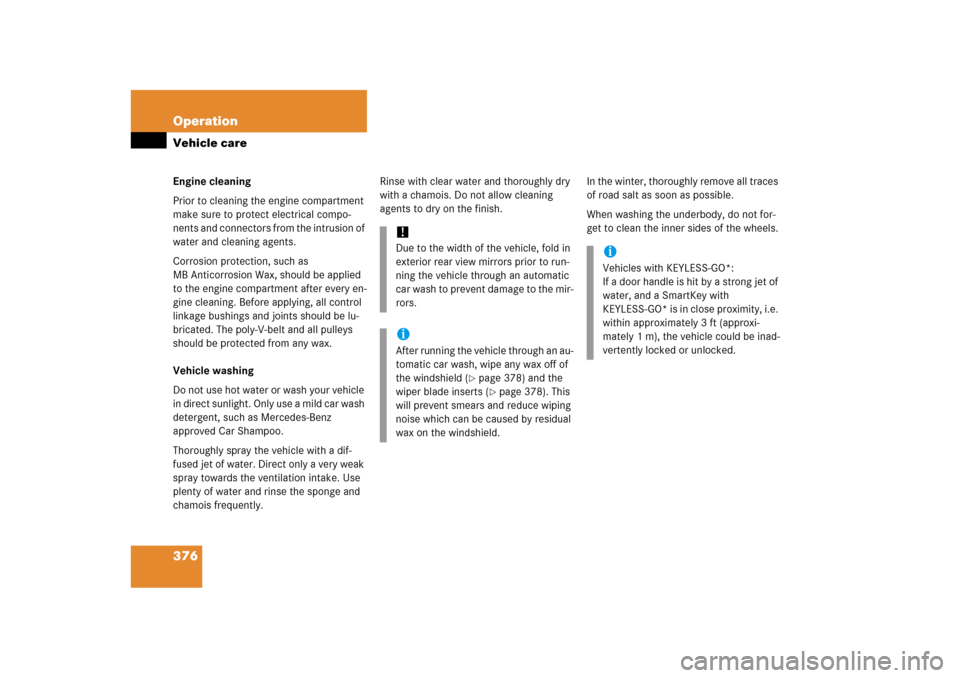Page 377 of 539

376 OperationVehicle careEngine cleaning
Prior to cleaning the engine compartment
make sure to protect electrical compo-
nents and connectors from the intrusion of
water and cleaning agents.
Corrosion protection, such as
MB Anticorrosion Wax, should be applied
to the engine compartment after every en-
gine cleaning. Before applying, all control
linkage bushings and joints should be lu-
bricated. The poly-V-belt and all pulleys
should be protected from any wax.
Vehicle washing
Do not use hot water or wash your vehicle
in direct sunlight. Only use a mild car wash
detergent, such as Mercedes-Benz
approved Car Shampoo.
Thoroughly spray the vehicle with a dif-
fused jet of water. Direct only a very weak
spray towards the ventilation intake. Use
plenty of water and rinse the sponge and
chamois frequently.Rinse with clear water and thoroughly dry
with a chamois. Do not allow cleaning
agents to dry on the finish.In the winter, thoroughly remove all traces
of road salt as soon as possible.
When washing the underbody, do not for-
get to clean the inner sides of the wheels.
!Due to the width of the vehicle, fold in
exterior rear view mirrors prior to run-
ning the vehicle through an automatic
car wash to prevent damage to the mir-
rors.iAfter running the vehicle through an au-
tomatic car wash, wipe any wax off of
the windshield (
�page 378) and the
wiper blade inserts (�page 378). This
will prevent smears and reduce wiping
noise which can be caused by residual
wax on the windshield.
iVehicles with KEYLESS-GO*:
If a door handle is hit by a strong jet of
water, and a SmartKey with
KEYLESS-GO* is in close proximity, i.e.
within approximately 3 ft (approxi-
mately 1 m), the vehicle could be inad-
vertently locked or unlocked.
Page 389 of 539
388 Practical hintsWhat to do if …Problem
Possible cause
Suggested solution
The yellow fuel tank reserve
warning lamp comes on while
driving.
The fuel level has gone below the reserve
mark.
�
Refuel at the next gas station
(�page 323).
<
The red seat belt telltale comes
on and a warning chime sounds
for approximately six seconds af-
ter starting the engine with all
doors closed.
The seat belt telltale reminds you and your
passengers to fasten your seat belts before
driving off.
�
Fasten your seat belts.
The seat belt telltale goes out.
Page 408 of 539

407 Practical hints
What to do if …
Symbol messagesDisplay symbol
Display messages
Possible cause
Possible solution
#
Undervoltage
Switch off consumers
The battery has insufficient volt-
age.
�
Turn off unnecessary electrical
consumers.
malfunction
Visit workshop
The battery was charged with a
battery charger or jump started.
�
Have the battery checked at a service
station.
Battery/Alternator
Stop vehicle
The battery is no longer charg-
ing.
Possible causes:�
alternator malfunctioning
�
broken poly-V-belt
Do not forget that the brake sys-
tem requires electrical energy
and may be operating with re-
stricted capability. Considerably
greater brake pedal force is
required and the stopping dis-
tance is increased.
�
Stop immediately and check the
poly-V-belt.
If it is broken:
�
Do not continue to drive. Otherwise the
engine will overheat due to an inoperative
water pump which may result in damage
to the engine. Notify an authorized
Mercedes-Benz Light Truck Center.
If it is intact:
�
Drive immediately to the nearest autho-
rized Mercedes-Benz Light Truck Center.
Adjust driving to be consistent with re-
duced braking responsiveness.
Page 413 of 539
412 Practical hintsWhat to do if …Display symbol
Display messages
Possible cause
Possible solution
Ï
Coolant
Stop, engine off
The poly-V-belt could be broken.
�
Stop the vehicle and immediately turn off
the engine.
�
Check the poly-V-belt.
If it is broken:
�
Do not continue to drive. Otherwise the
engine will overheat due to an inoperative
water pump which may result in damage
to the engine. Notify an authorized
Mercedes-Benz Light Truck Center.
If it is intact:
�
Do not continue to drive the vehicle with
this message displayed. Doing so could
result in serious engine damage that is
not covered by the Mercedes-Benz Limit-
ed Warranty.
�
Drive immediately to the nearest autho-
rized Mercedes-Benz Light Truck Center.
Coolant
Visit workshop
The cooling fan for the coolant is
malfunctioning.
�
Observe the coolant temperature gauge
in the instrument cluster.
�
Have the fan replaced as soon as possi-
ble.
Page 482 of 539
481 Technical data
Parts service
Warranty coverage
Identification labels
Layout of poly-V-belt drive
Engine
Rims and tires
Electrical system
Main Dimensions
Weights
Fuels, coolants, lubricants, etc.
Page 487 of 539
486 Technical dataEngineModel
ML 350 (164.186
1)
1The quoted data apply only to the standard vehicle. See an authorized Mercedes-Benz Light Truck Center for the corresponding data of all special bodies and special
equipment.
ML 500 (164.175
1)
Engine
272
113
Mode of operation
4-stroke engine, gasoline injection
4-stroke engine, gasoline injection
No. of cylinders
6
8
Bore
3.66 in (92.90 mm)
3.81 in (97.00 mm)
Stroke
3.38 in (86.00 mm)
3.31 in (84.00 mm)
Total piston displacement
213 cu in (3498 cm
3)
303 cu in (4966 cm
3)
Compression ratio
10.7:1
10:1
Output acc. to SAE J 1349
268 hp/6000 rpm
2
(200 kW/6000 rpm)
2Premium fuel required. Performance may vary with fuel octane rating.
302 hp/5600 rpm
2
(225 kW/5600 rpm)
Maximum torque acc. to SAE J 1349
258 lb-ft/2400-5000 rpm
(350 Nm/2400-5000 rpm)
339 lb-ft/2700-4750 rpm
(460 Nm/2700-4750 rpm)
Maximum engine speed
6500 rpm
6300 rpm
Firing order
1-4-3-6-2-5
1-5-4-2-6-3-7-8
Poly-V-belt
2 404 mm
2370 mm
Page 503 of 539

502 Technical termsControl system
The control system is used to call up
vehicle information and to change
component settings. Information and
messages appear in the multifunction
display. The driver uses the buttons on
the multifunction steering wheel to
navigate through the system and to ad-
just settings.
Cruise control
Driving convenience system for
automatically maintaining the vehicle
speed set by the driver.
Curb weight
(
�page 365)
DOT
(Department o
f Transportation)
(
�page 365)
DSR
(Downhill S
peed R
egulation)
Driving convenience system for auto-
matically maintaining the vehicle speed
on downhill driving.Engine number
The number set by the manufacturer
and placed on the cylinder block to
uniquely identify each engine
produced.
Engine oil viscosity
Measurement for the inner friction (vis-
cosity) of the oil at different tempera-
tures. The higher the temperature an
oil can tolerate without becoming thin,
or the lower the temperature it can tol-
erate without becoming viscous, the
better the viscosity.
ESP
®(Electronic S
tability Pr
ogram
®)
Improves vehicle handling and direc-
tional stability.
ETD
(E
mergency T
ensioning D
evice)
Device which deploys in certain frontal
and rear collisions exceeding the
system’s threshold to tighten the seat
belts.
->SRSFSS PLUS (Canada vehicles)
(F
lexible S
ervice S
ystem PLUS)
Maintenance service indicator in the
multifunction display that informs the
driver when the next vehicle mainte-
nance service is due. FSS evaluates en-
gine temperature, oil level, vehicle
speed, engine speed, distance driven
and the time elapsed since your last
maintenance service, and calls for the
next maintenance service accordingly.
GAWR
(G
ross A
xle W
eight R
ating)
The GAWR is the maximum permissible
axle weight. The gross vehicle weight
on each axle must never exceed the
GAWR for the front and rear axle indi-
cated on the certification label located
on the driver’s door pillar.
Page 505 of 539

504 Technical termsMaximum tire inflation pressure
(
�page 366)
Modular COMAND System
Information and operating center for
vehicle sound and communications
systems, including the radio and the ra-
dio and navigation system, as well as
for other optional equipment (CD
changer, telephone, etc.).
Memory function*
Used to store three individual seat,
steering wheel and exterior mirror
positions.
MON
(Motor O
ctane N
umber)
The Motor Octane Number for gasoline
as determined by a standardized meth-
od. It is an indication of a gasoline’s
ability to resist undesired detonation
(knocking). The average of both the
MON (Motor Octane Number) and
->RON (Research Octane Number) is
posted at the pump, also known as
ANTI-KNOCK INDEX.Multifunction display
The display field in the instrument clus-
ter used to present information provid-
ed by the control system.
Multifunction steering wheel
Steering wheel with buttons for operat-
ing the control system.
Normal occupant weight
(
�page 366)
OCS
(Occupant C
lassification S
ystem)
The system automatically turns the
front passenger front air bag on or off
based on the classified occupant size
category determined by weight sensor
readings from the seat.
Overspeed range
Engine speeds within the red marking
on the tachometer dial. Avoid this en-
gine speed range, as it may result in se-
rious engine damage that is not
covered by the Mercedes-Benz Limited
Warranty.Parktronic (Parking assist)*
System which uses visual and acoustic
signals to assist the driver during park-
ing maneuvers.
Poly-V-belt drive
Drives engine-components (alternator,
AC compressor, etc.) from the engine.
Power train
Collective term designating all compo-
nents used to generate and transmit
motive power to the drive axles, includ-
ing
�
Engine
�
Clutch/torque converter
�
Transmission
�
Transfer case
�
Drive shaft
�
Differential
�
Axle shafts/axles